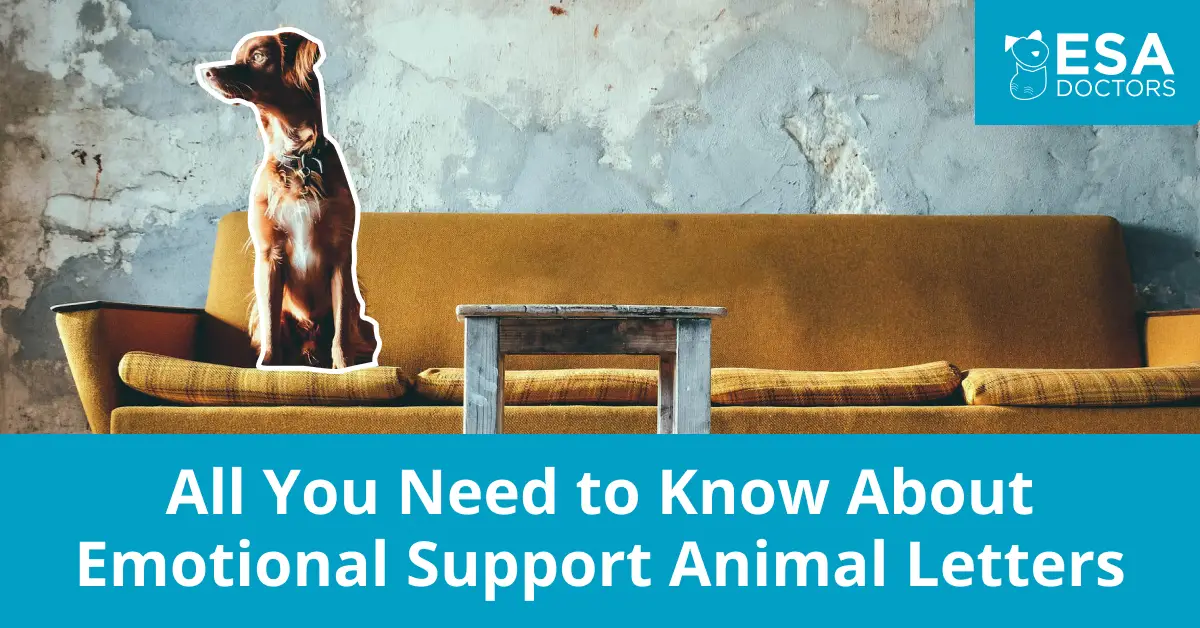No, your emotional support animal doesn’t need a vest, but wearing one can prevent daily headaches in apartments and other housing situations.
You don’t need a vest under HUD housing rules because an ESA letter from a licensed mental health professional is the only thing needed to qualify for an emotional support animal. No federal law requires vests, tags, or special gear for ESAs.
Your landlord also can’t demand that your animal wear identification. The Fair Housing Act protects you based on your letter, not your animal’s appearance. Some landlords try to require vests anyway, but they’re wrong. Your rights don’t change based on what your animal wears.
When a Vest Helps
Neighbor Complaints
Say you live in a building that doesn’t allow pets. You have proper ESA documentation for your dog, but neighbors keep complaining to management about “the illegal dog in your unit.”
If your dog wears an ESA vest, your neighbors will immediately know you have a support animal that is legally protected. You can take your dog outside without explaining yourself to concerned neighbors every single day.
Prevents Staff Confusion
Maintenance workers see an animal in a no-pet building and assume someone’s breaking the rules. They report violations and waste everyone’s time. The same goes with the security guards and front desk workers.
A vest gives the employees instant context, so they understand the situation and move on with their day.
Cuts Down Daily Stress
If you live in a large apartment complex, every trip to the parking garage might raise a question if you live in no-pets housing. Every mailbox visit might bring stares. New residents, unfamiliar with your ESA, might complain to management about your animal.
The vest can eliminate most of these interactions. Your stress drops because you can live normally without constant explanations.
Prevents Aggressive Confrontations
Some neighbors become very upset about pets in no-pet buildings. They might corner you in the hallway or leave nasty notes on your door about rule-breaking.
The vest often stops these confrontations before they start, once they realize they misunderstood the situation, rather than escalating it.
Choosing an ESA Vest
Think about your daily routine. Do you live in a large building with lots of turnover? Do you regularly face questions about your animal? Does the building staff seem confused about ESA rules?
If yes, try a vest for a month. Many find it’s worth it just to reduce how often they have to explain themselves. Others prefer educating people individually.
You can always change your mind. The vest is just a communication tool, not a permanent decision. If you do choose to get a vest, pick something simple with “Emotional Support Animal” or “Do Not Pet” in clear letters. Skip fancy patches or service animal labels (Never mislead people into thinking you have a service dog!). Focus on comfort for your animal since they’ll wear it regularly.
Your ESA’s role is to support your mental health — whether they wear an ESA vest is entirely your choice.





The rights for Air Travel have been updated. In December 2020, the United States Department of Transportation (DOT) announced final revisions to its Air Carrier Access Act (ACAA). The final rule, effective in January 2021, states that ESAs are considered pets and do not have the same rights as License Service Animals.
We have written several articles about the change in air travel rules, for example: https://esadoctors.com/how-to-fly-with-a-dog-travel-guide/
https://esadoctors.com/dot-service-animal-air-transportation-form/
Am I allowed to place a “service dog” vest on an ESA (instead of the “emotional support dog” vest?)
No, that would be misleading and inaccurate. An ESA is not the same thing as a service dog. A service dog must be trained to perform tasks relating to a person’s disability.
Is it okay to use a service dog vest for a emotional support dog?
There’s no rule against it, as long as you’re aware that it doesn’t confer any legal rights on its own and should only be used with an actual emotional support animal.
I wouldn’t walk my dog in toxic waste either. A seven month old cannot break that stuff down like an adult dog does. And, yes your ESA can go anywhere outside that you go. To keep peace with the homeowners association, try your furbaby in a set of quad boots. There waterproof, will protect his paws from heat and cold. Furbaby is young enough to take to them if it’s fun. My device dog where’s Bunny boots when on black asphalt. I played peek-a-boo with her foot until she begged to have her Hoppy Feet on.
I’m currently dealing with my condo association. They are telling me that I can’t walk my dog outside in front of the condo buildings and on the parking lot and that I MUST walk him behind the building in the grassy area. The issue is that the grass in our complex is treated with a bad pesticide that is toxic for animals. My pup is only 7 months old and I do not want to put him in harms way. We have a note that he is currently an ESA from our doctor. Is there anything I can do to say “no I’m not walking my dog back there?”
ESAs generally must be allowed in common areas where other tenants are allowed to go.
I was told that if I place a ESA tag or bandana on my dogs, it is a federal offense. Is this true? If so, can you provide me with a link saying this?
We’re not aware of anything that says that is an offense. It is however unethical and potentially illegal to falsely claim a pet is an assistance animal.
So an ESA animal can be denied entrance into a grocery store?
Yes, ESAs do not have a legal right to be in grocery stores. A grocery store may have their own policy regarding pets or ESAs and allow them, but they are not obligated to.
I think emotional support animals do not have as many rights as service animals, they do have rights when it comes to air travel and housing.
That is correct, ESAs have more limited rights than service animals. ESAs have rights when it comes to housing and air travel only.
I own a hair salon in Kansas, what are the guidelines for letting clients bring dogs in without a vest.
Service dog, therapy dog ? To protect yourself & your business from getting fined because of no dogs allowed policy ?
ESAs do not have an automatic right to be in a hair salon. Service animals however must be given access to places where other members of the public are allowed, such as a hair salon. If it is not immediately apparent the animal is a service animal, you can ask two questions: (1) is the dog a service animal required because of a disability? and (2) what work or task has the dog been trained to perform?
Hi I already have a letter from my psychiatrist for my ESA cat. All I need is a collar indicating that she is an ESA animal. So I just need to know how much the colors are and also I need to know where I can register her for a decent price as an ESA animal. Please get back to me as soon as possible thank you Stefanie Acker
If you have an ESA letter from your psychiatrist that is all you will need to request reasonable accommodation from your landlord. You do not need a collar, vest or ID for your emotional support animal. These items do not confer any official status on an animal.
How can landlord make sure ESA letter is official and not just a fake?
A valid ESA letter will come from a licensed health care provider, contain the LHCP’s license number and be signed and dated by the professional. You may find this article helpful to learn about how to differentiate between legitimate and fake ESA letters: https://esadoctors.com/dont-be-scammed-fake-esa-letters/